Butchering The Beatles
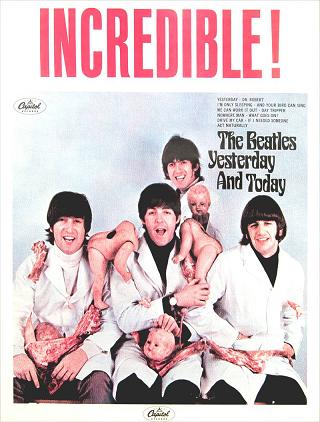
A supposed promtional poster for Yesterday and Today that was actually created in the 80's. No promotional material was issued originally or the record might never have made it into stores at all!
With collecting vinyl records coming back into favor, it is also attracting a younger group of enthusiasts who did not have the good fortune of growing up with the format. A younger friend of mine and I were recently discussing the infamous original version of the Beatles album Yesterday and Today, which has come to be known as the “Butcher Cover”. He knew that such a thing existed and was highly prized among Beatles collectors but had not idea why it ever existed in the first place. So for those newly into the hobby of record collecting or those who missed it the first time, here is the story of the only original Beatles album that Capitol Records lost money on.
It’s hard to fathom all these years in the future but Capitol Records, the American branch of EMI who signed the Beatles to their Parlophone label in England, actually passed on the group when they were initially offered to them. The executives at Capitol felt the Beatles’ sound was a flash in the pan and their was no point in wasting their time on something that wasn’t going to last. Instead, the Beatles’ first album, which was released as Please, Please Me in England, went to the Vee Jay Records, a small label based in Chicago. Feeling the album needed some reworking for American consumers, Vee Jay re-titled it Introducing the Beatles and used a more traditional looking photo of the group on the cover. Shortly thereafter, Beatlemania swept the US by storm and Capitol managed to regain control of the distribution rights shortly before their second album was ready to be released overseas. Vee Jay’s reworking of Please, Please Me was nothing new in America but Capitol Records was about to turn the unsavory practice into an art form.
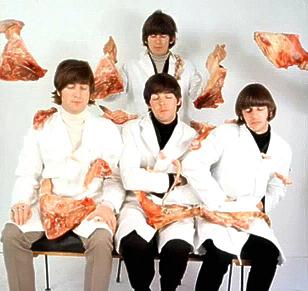
An alternate photo from the session that produced the Butcher Cover.
In 1960’s England, records were typically available in three formats. The twelve inch LP (long playing record) which usually had fourteen tracks, the EP (extended play record) which were seven inches in diameter and recorded at the same speed as an LP, 33 1/3, and also the seven inch 45 or single which had one track on each side and was recorded at 45RPM. Normally one or two EPs would be released from each album. These contained four of the best tracks from the album and were aimed at people who could not afford the LP. Singles in England were generally unique material that was not featured on an album. After their initial under estimation of the Beatles, Capitol intended to make up for lost time and milk this cash cow as hard and as fast as they could and that meant releasing as much vinyl as possible.
The EP format in America was almost nonexistent; US fans were content with albums and singles. When a new Beatles LP would arrive, Capitol would remove anywhere from two to four tracks from it and hold them for future use. They also made sure that the A and often the B sides of singles ended up on the albums as well so that was another one to two tracks that could be removed and still keep the average number of songs on a US Beatles album at ten to twelve. The end was result of this practice was that for every two Beatles albums released in England, Capitol could easily put out three in America. The process proved so successful that Capitol even padded the soundtracks to the Beatles first two movies with instrumentals and scavenged half the tracks for other LPs!
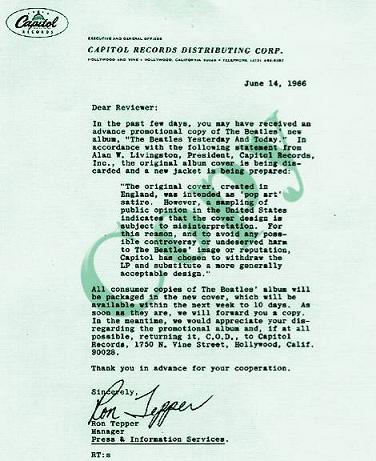
The Capitol Records notice of recall for the original version of Yesterday and Today.
Aside from questionable ethics and fleecing US Beatles fans, Capitol’s reworking of albums was difficult on the Beatles. They were never sure what tracks had ended up on which album in America so they had to stop providing references at their concerts. They also felt that their musical integrity was being compromised since they had considerable control over the structure of an album in England but no say at all in America. The situation all came to a head in July of 1966 with the release of their eleventh album, they had only released six albums in the UK by this point, on the Capitol label, Yesterday and Today.
Yesterday and Today was an odd but surprisingly effective conglomeration of recent Beatles’ tracks, plus three that had not been released at all at that point. From the UK version of Help, Capitol scavenged the title track, Yesterday, and the song they had coupled it with for a US single, Act Naturally. From Rubber Soul, they purloined Drive My Car, If I Needed Someone, Nowhere Man, and What Goes On. The Revolver album was still several weeks away from release anywhere but that didn’t stop Capitol from borrowing three tracks, Dr. Robert, And Your Bird Can Sing, and I’m Only Sleeping. To pad the final product out to a respectable, by US standards at least, eleven tracks, they also added in both sides of the recent single We Can Work It Out and Day Tripper. This was a strange coupling of musical product spanning two years in the Beatles’ career but the lineup works surprisingly well – it was certainly better than many of Capitol’s earlier fabricated albums but the real snag was about to surface.
Once the tracks for the album had been established, Capitol contacted the English offices of EMI for a current photograph of the band to use for the cover. A few months earlier, the Beatles had done a session with Roger Whitaker, a highly respected photographer who specialized in musical groups. Unlike other photographs he had taken of the Beatles over the years, Whitaker envisioned this shoot as more of a conceptual piece and he took many pictures of the group and its individual members with a variety of strange props and in odd poses. The most well known of these photographs had the Beatles wearing butcher’s smocks and surrounded by raw meat, dismembered baby dolls, and various other unpleasant items like false teeth and glass eyes. The shot was used in England for print advertising promoting the forthcoming single Paperback Writer and Rain (two songs which Capitol surprisingly did not use on the Yesterday and Today album) and went largely unnoticed in the UK. Whoever actually selected this photograph for the potential cover of a new US Beatles album has been lost to time but Capitol Records obviously read nothing into it initially and found it perfectly acceptable for their product. It was a decision they would very quickly come to regret.
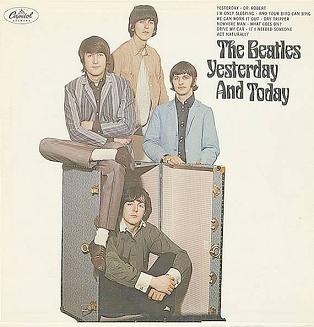
The second version of Yesterday and Today known as the Trunk Cover.
The first run pressings of Yesterday and Today are estimated to have numbered at approximately 750,000 copies and were assembled at several of Capitol’s record plants in the United States. Almost as soon as the first promotional copies reached radio stations and music reviewers, the public disapproval became known. Many records stores, which received their pre-ordered copies about a week later, refused to put it on the shelves and those that did offer it for sale usually removed it quickly due to customer complaints. Within five days of the album arriving at record stores, the parent company of Capitol, EMI, issued a recall notice of all unsold copies and Yesterday and Today vanished before many Beatles fans even realized it was released.
After initially ordering the recalled covers to be destroyed, Capitol changed its mind and decided it would be more cost effective to paste slicks of the new cover photograph, which showed a disinterested set of Beatles surrounding a steamer trunk, over the existing ones. As these revamped albums slowly found their way back into stores along with the newly printed versions, word of the switch circulated among fans and they began to search out the albums that still had the original photo just under the surface. Finding a butcher cover wasn’t that difficult in the first few weeks of the re-release but peeling it, which almost any self respecting Beatles fan just had to try, was another matter. The glue used to adhere the new paper cover was resilient and, unless great time and care was taken during the removal process, it tended to take large portions of the old cover along with it. A significant number of Butcher Covers were butchered themselves in this fashion and the number of surviving original album covers, which was already small, continued to dwindle.
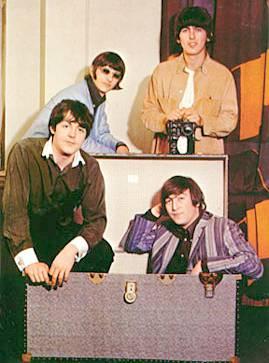
An alternate photo from the session for the Trunk Cover.
While the exact intent of the Butcher Cover will probably always remain a subject of conjecture, one fact is certain – following this release, Capitol never tampered with another Beatles album again. A few months later, the Revolver album was issued without the three tracks that already been removed but from that point forward, beginning with Sgt. Pepper’s Lonely Hearts Club Band, every Beatles album released in England was issued the same way in America. Capitol still made a number of unique products in the US but they were far less intrusive after the Butcher Cover fiasco. When the Beatles released the soundtrack to their one and only television special, Magical Mystery Tour, as a double EP in England, Capitol padded this into an album in the US using tracks from recent singles. Since the EP format was unpopular almost anywhere other than Britain, this album became the preferred version of the product in the remainder of the world. After the Beatles broke up in 1970 and Capitol realized they would have no new products for the Christmas season that year, they hastily cobbled together some newer single tracks with an odd selection of material from years earlier and fabricated an album called The Beatles Again. Aside from the fact that fans hated the title and it was eventually changed to Hey Jude, the album was a popular seller.
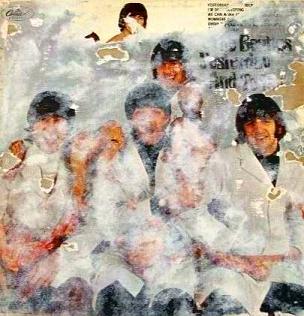
Why you don't want to try to peel a Butcher Cover unless you are sure you know what you are doing!
The Butcher Cover version of Yesterday and Today has passed into Beatles legend and become a very sought after and valuable item among collectors. The surviving albums are divided into three categories for identification. “First state” covers are the rarest of the three and are those original albums that never had a slick pasted over them. These can usually be differentiated from a very well peeled cover by the lack of any residual glue even forty-five years later. Covers which had the slick pasted on but were never peeled are called “second state” and are almost as rare, although not as desirable, as first state covers because so many fans just had to try and get to the cover below it. While many successful methods of peeling the slicks were devised over the years, most collectibles appraisers would recommend that they be left as is after all this time to avoid decreasing the value. The final and most common version is the “third state” or peeled cover. These range in quality from being almost identical to a first state cover to having more of the original cover torn off than left on and the value varies widely accordingly. Nothing can really be done to restore a Butcher Cover that has been poorly peeled but that still doesn’t make it uncollectible and it can always be upgraded with another copy in the future.
So there you have it, the only Beatles album Capitol Records lost money one due to the expense of shipping the albums back to the plants and reworking and reprinting close to a million copies. Next time you are in a place that carries used records and you find an original copy of the Yesterday and Today album on the black Capitol label with the rainbow border, take a very close look at it. If you are holding an unrecognized second state cover with the slick in tact, you will be able to spot dark patches in the white areas of the paste over. The black sweaters the Beatles were wearing under their smocks and their brow hair are two of the most obvious pieces to bleed through. A common issue of the album shouldn’t set you back too much and there could really be buried treasure underneath but you may want to consider leaving it hidden.
